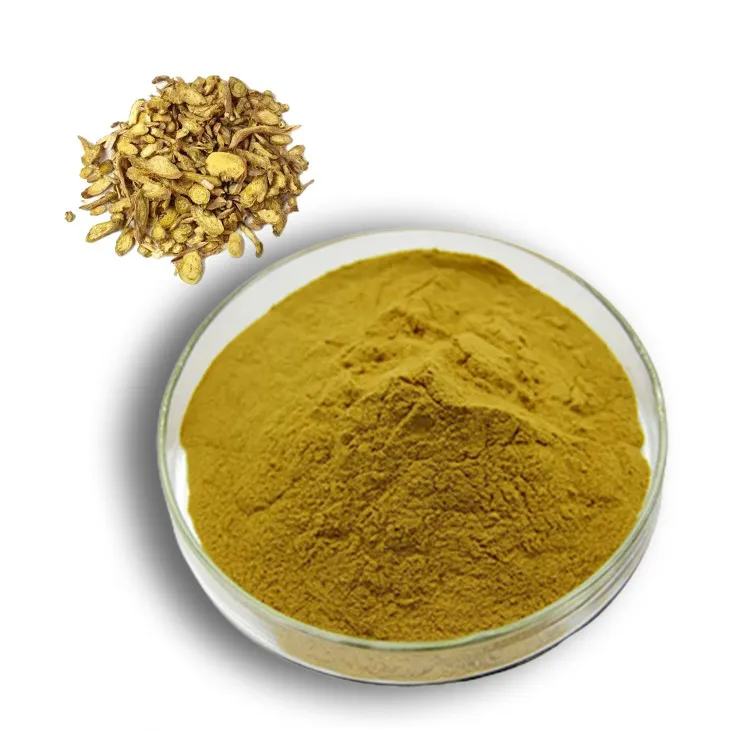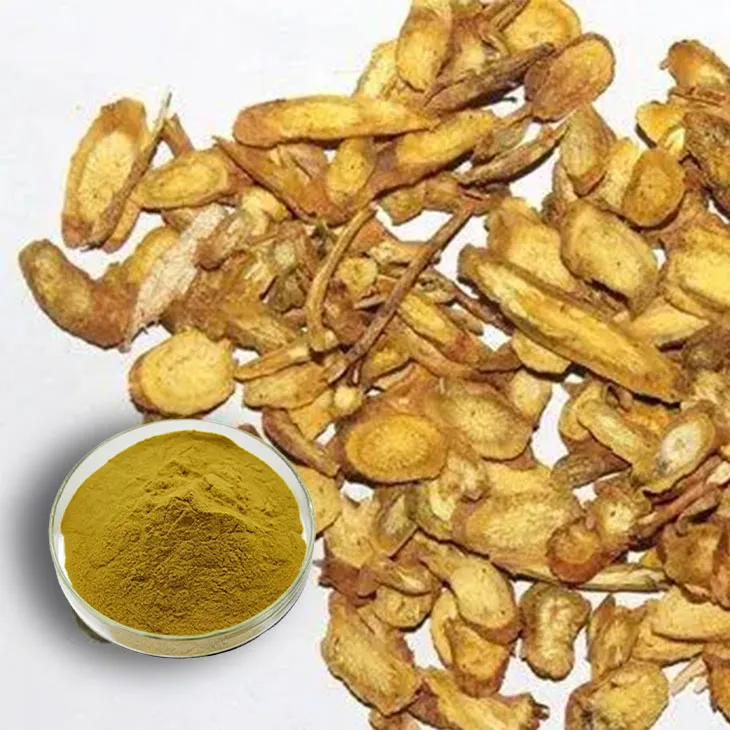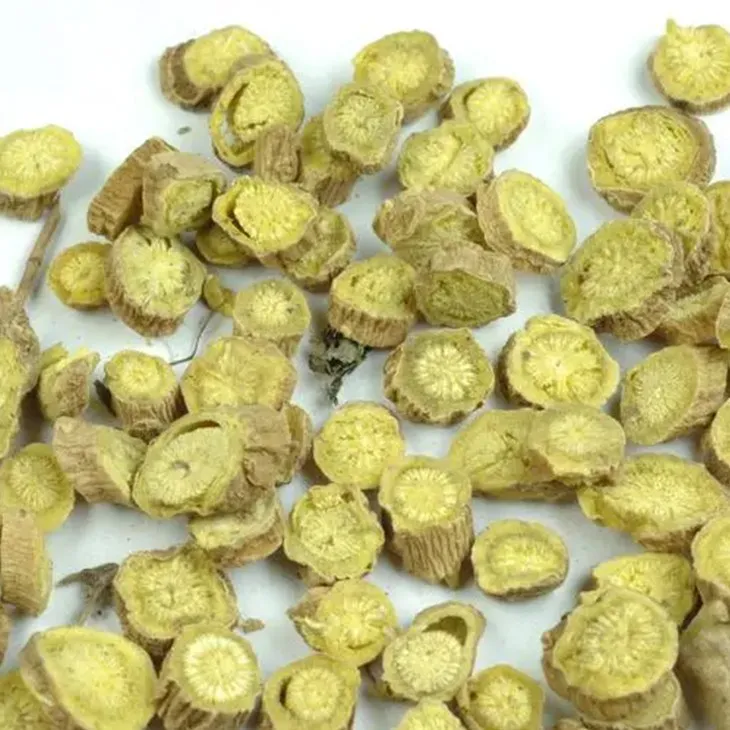- 0086-571-85302990
- sales@greenskybio.com
The process of extracting baicalin monomer from baicalin.
2024-11-27

1. Introduction
Baicalin is a significant bioactive compound with a wide range of potential applications, especially in the pharmaceutical field. Extracting its monomer from Baicalin is of great importance as it can enhance the purity and specificity of its biological activities. This article will comprehensively discuss the processes involved in the extraction of Baicalin monomer.

2. Soxhlet Extraction
2.1 Principle
The Soxhlet extraction method is a well - known and widely used technique for extracting substances from solid materials. In the case of baicalin extraction, it works on the principle of continuous extraction. A solvent, such as ethyl acetate, is used to dissolve the baicalin present in the raw materials. The Soxhlet apparatus allows the solvent to be recycled continuously over a period of time, ensuring efficient extraction.
2.2 Procedure
- First, the raw materials containing baicalin are prepared. These can be plant parts rich in baicalin, which are usually dried and ground into a fine powder to increase the surface area available for extraction.
- The powdered raw material is placed in a thimble within the Soxhlet apparatus. The thimble is designed to hold the sample while allowing the solvent to pass through it.
- Ethyl acetate (or other suitable solvents) is poured into the Soxhlet flask. The flask is then heated. As the solvent vaporizes, it rises up through a sidearm and condenses in a condenser.
- The condensed solvent drips onto the sample in the thimble, dissolving the baicalin. The solvent, now containing the dissolved baicalin, then siphons back down into the Soxhlet flask.
- This cycle of vaporization, condensation, extraction, and siphoning is repeated multiple times over a few hours to days, depending on the nature of the sample and the required extraction efficiency.
2.3 Advantages and Limitations
-
Advantages:
- It is a relatively simple and cost - effective method. The Soxhlet apparatus is not overly complex and can be easily set up in a laboratory setting.
- It provides good extraction efficiency for baicalin as the continuous recycling of the solvent ensures that a large amount of the target compound is extracted over time.
-
Limitations:
- The extraction process can be time - consuming, especially when a high degree of extraction is required. This can be a drawback when dealing with large - scale production or when time is a crucial factor.
- The use of organic solvents like ethyl acetate may pose environmental and safety concerns. These solvents are often flammable and may require proper ventilation and handling procedures.

3. Preparative High - Performance Liquid Chromatography (HPLC)
3.1 Principle
Preparative HPLC is a powerful purification method. It operates on the principle of separating components in a mixture based on their differential interactions with a stationary phase and a mobile phase. In the case of baicalin monomer purification, a high - pressure pump is used to drive the mobile phase (a solvent or a mixture of solvents) through a column filled with a specific stationary phase. Compounds in the sample, including baicalin and other impurities, interact differently with the stationary phase. Baicalin, due to its unique chemical structure, will have a specific retention time and elution behavior. The detection system of HPLC can monitor the eluting components and precisely identify the fraction containing the baicalin monomer, which can then be collected.
3.2 Procedure
- Sample Preparation: The extract obtained from the Soxhlet extraction (or other extraction methods) is first prepared. This may involve filtering the extract to remove any particulate matter and diluting it to an appropriate concentration for injection into the HPLC system.
- Column Selection: A suitable column with the appropriate stationary phase is selected. The choice of column depends on the nature of the sample and the specific requirements for separating baicalin monomer. For example, columns with reversed - phase stationary phases are often used for baicalin purification.
- Mobile Phase Optimization: The mobile phase composition is optimized. This may involve adjusting the ratio of solvents (such as water - methanol or water - acetonitrile mixtures) to achieve the best separation of baicalin from other components in the sample. The pH of the mobile phase may also be adjusted if necessary.
- Injection and Separation: The prepared sample is injected into the HPLC system. As the mobile phase flows through the column, the components in the sample begin to separate based on their interactions with the stationary phase. The baicalin monomer will elute at a specific time, which is detected by the HPLC detector.
- Collection: Once the detector identifies the fraction containing the baicalin monomer, a collection device is used to collect this fraction. This fraction can then be further processed or analyzed.
3.3 Advantages and Limitations
-
Advantages:
- High - precision separation: HPLC can achieve very high - precision separation of baicalin monomer from complex mixtures. This ensures a high - purity product, which is crucial for pharmaceutical applications.
- Automation and reproducibility: Modern HPLC systems are highly automated, allowing for consistent and reproducible results. This is important for large - scale production and quality control.
-
Limitations:
- High cost: The equipment for preparative HPLC is expensive, including the high - pressure pump, the column, and the detector. This can be a significant investment for small laboratories or research projects.
- Limited sample capacity: The amount of sample that can be processed in a single run of preparative HPLC is relatively limited. This may require multiple runs for large - volume samples, increasing the overall processing time and cost.

4. Enzyme - Assisted Extraction
4.1 Principle
Enzyme - assisted extraction is based on the use of specific enzymes to break down the cell walls of plants more effectively. In the context of baicalin extraction, certain enzymes can target the components of plant cell walls, such as cellulose and hemicellulose. By breaking down these cell wall components, the release of baicalin from the plant material is facilitated. This is because baicalin is often trapped within the cells of the plant, and breaking the cell walls makes it more accessible to the extraction solvent.
4.2 Procedure
- Enzyme Selection: The first step is to select the appropriate enzyme or enzyme cocktail. For baicalin extraction from plant sources, enzymes such as cellulases and hemicellulases may be used. These enzymes are chosen based on the composition of the plant cell walls in the source material.
- Preparation of the Reaction Mixture: The plant material containing baicalin is mixed with the selected enzyme(s) in a suitable buffer solution. The buffer is used to maintain the optimal pH and temperature conditions for the enzyme activity. The concentration of the enzyme and the ratio of enzyme to plant material are optimized based on preliminary experiments.
- Incubation: The reaction mixture is incubated at a specific temperature and for a certain period of time. This allows the enzymes to act on the plant cell walls and break them down. The temperature and time of incubation are critical factors and are determined based on the characteristics of the enzyme and the nature of the plant material. For example, cellulases may typically work best at around 40 - 50°C for a few hours.
- Extraction: After the incubation period, an extraction solvent (such as ethyl acetate or methanol) is added to the reaction mixture to extract the baicalin that has been released from the plant cells. The extraction process is similar to the traditional extraction methods, such as Soxhlet extraction, but the prior enzyme treatment is expected to increase the extraction efficiency.
- Separation and Purification: The extract obtained after enzyme - assisted extraction still contains impurities. Therefore, subsequent separation and purification steps, such as filtration, centrifugation, and preparative HPLC, are required to obtain the pure baicalin monomer.
4.3 Advantages and Limitations
-
Advantages:
- Enhanced extraction efficiency: The use of enzymes can significantly increase the extraction yield of baicalin. By breaking down the cell walls, more baicalin can be released from the plant material, resulting in a higher amount of baicalin in the extract.
- Environment - friendly: Compared to some traditional extraction methods that may use harsh chemicals, enzyme - assisted extraction is generally more environmentally friendly. Enzymes are biodegradable and operate under milder reaction conditions.
-
Limitations:
- Enzyme cost and stability: The cost of enzymes can be relatively high, especially for large - scale extraction operations. Additionally, enzymes are often sensitive to environmental conditions such as temperature and pH, and maintaining their stability during the extraction process can be challenging.
- Specificity and complexity: The effectiveness of enzyme - assisted extraction depends on the specificity of the enzymes used. If the wrong enzyme or enzyme combination is selected, the extraction efficiency may not be improved as expected. Also, the overall process can be more complex due to the need to optimize enzyme - related parameters such as concentration, temperature, and time.

5. Conclusion
The extraction of baicalin monomer from baicalin is a complex but important process. Each of the methods discussed, namely Soxhlet extraction, preparative HPLC, and enzyme - assisted extraction, has its own advantages and limitations. Soxhlet extraction is a simple and cost - effective initial extraction method, but it may be time - consuming and have environmental concerns. Preparative HPLC offers high - precision separation but is expensive and has limited sample capacity. Enzyme - assisted extraction can enhance extraction efficiency in an environmentally friendly way, but has issues related to enzyme cost and stability. Future research may focus on combining these methods or developing new techniques to overcome the limitations and improve the overall efficiency and quality of baicalin monomer extraction for various applications, especially in the pharmaceutical industry.
FAQ:
What are the advantages of Soxhlet extraction in extracting baicalin monomer?
Soxhlet extraction has the advantage of being able to continuously extract baicalin from raw materials over a period of time. It can effectively use the solvent (such as ethyl acetate) to dissolve and extract baicalin, which helps to obtain a relatively concentrated extract containing baicalin for further purification to get the monomer.
How does preparative high - performance liquid chromatography (HPLC) separate baicalin monomer accurately?
Preparative HPLC uses a high - pressure pump to drive the mobile phase through a column filled with a specific stationary phase. Different components in the complex mixture have different affinities for the stationary phase and mobile phase. Baicalin monomer will move at a specific speed in the column and be separated from other components. The detection system of HPLC can then precisely identify and collect the fraction containing the baicalin monomer.
What is the role of enzymes in enzyme - assisted extraction of baicalin monomer?
Enzymes in enzyme - assisted extraction play a crucial role. Specific enzymes can break down the cell walls of plants more effectively. By breaking down the cell walls, they facilitate the release of baicalin. This makes it easier to extract baicalin from the plant material, and through subsequent separation and purification steps, the baicalin monomer can be obtained with high purity.
Are there any limitations in the Soxhlet extraction method for baicalin monomer extraction?
Yes, there are limitations. Soxhlet extraction may require a relatively long extraction time. Also, the solvent used may not be completely selective, which may lead to the extraction of some other unwanted components along with baicalin. Moreover, the extraction process may not be very energy - efficient.
How can the purity of the obtained baicalin monomer be ensured?
To ensure the purity of the obtained baicalin monomer, a series of purification steps are usually carried out. After the initial extraction method like Soxhlet extraction, advanced purification techniques such as preparative HPLC are used. The proper selection of stationary and mobile phases in HPLC, as well as accurate control of operating parameters, can help to separate baicalin monomer from other impurities effectively, thus ensuring high purity.
Related literature
- Isolation and Characterization of Baicalin Monomer from Scutellaria baicalensis Georgi"
- "Efficient Extraction and Purification of Baicalin Monomer: A Review"
- "Advances in the Extraction Technologies of Baicalin Monomer for Pharmaceutical Applications"
- ▶ Hesperidin
- ▶ citrus bioflavonoids
- ▶ plant extract
- ▶ lycopene
- ▶ Diosmin
- ▶ Grape seed extract
- ▶ Sea buckthorn Juice Powder
- ▶ Beetroot powder
- ▶ Hops Extract
- ▶ Artichoke Extract
- ▶ Reishi mushroom extract
- ▶ Astaxanthin
- ▶ Green Tea Extract
- ▶ Curcumin Extract
- ▶ Horse Chestnut Extract
- ▶ Other Problems
- ▶ Boswellia Serrata Extract
- ▶ Resveratrol Extract
- ▶ Marigold Extract
- ▶ Grape Leaf Extract
- ▶ blog3
- ▶ blog4
-
Ginseng root extract manufacturers.
2024-11-27
-
Organic Olive Leaf Extract, Australia.
2024-11-27
-
The best organic green tea extract.
2024-11-27
-
Ashwagandha extract manufacturer.
2024-11-27
-
High - quality peppermint oil products.
2024-11-27
-
Garcinia Cambogia Extract
2024-11-27
-
Sugarcane Extract
2024-11-27
-
Resveratrol extract
2024-11-27
-
Lotus leaf extract
2024-11-27
-
Curcumin
2024-11-27
-
Soy Extract
2024-11-27
-
Golden Seal Extract
2024-11-27
-
Sea buckthorn Juice Powder
2024-11-27
-
Marigold Extract
2024-11-27
-
Genistein
2024-11-27





















